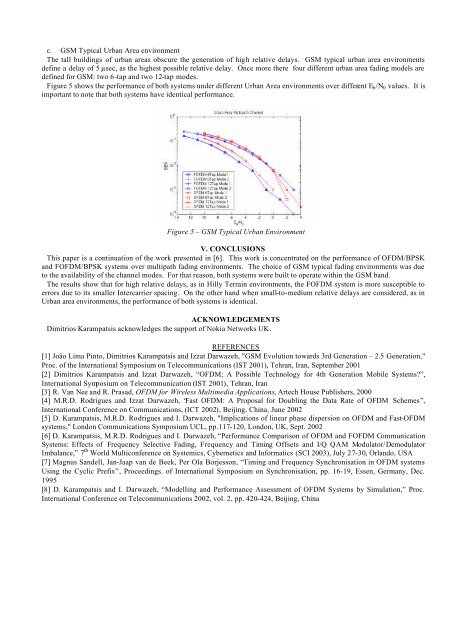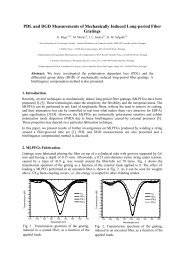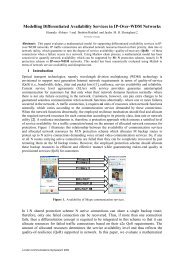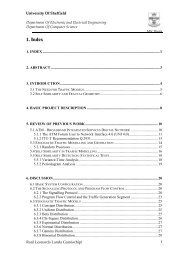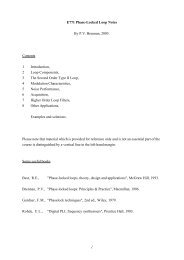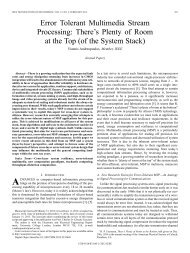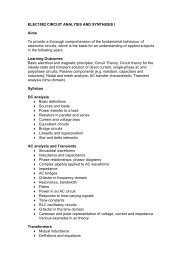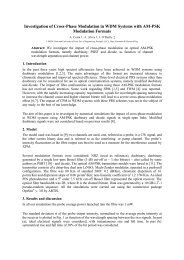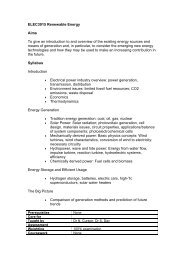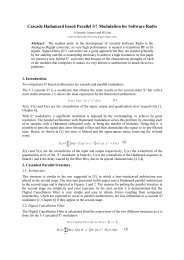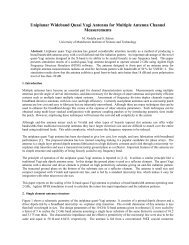Performance Comparison of OFDM and FOFDM Communication ...
Performance Comparison of OFDM and FOFDM Communication ...
Performance Comparison of OFDM and FOFDM Communication ...
You also want an ePaper? Increase the reach of your titles
YUMPU automatically turns print PDFs into web optimized ePapers that Google loves.
c. GSM Typical Urban Area environment<br />
The tall buildings <strong>of</strong> urban areas obscure the generation <strong>of</strong> high relative delays. GSM typical urban area environments<br />
define a delay <strong>of</strong> 5 µsec, as the highest possible relative delay. Once more there four different urban area fading models are<br />
defined for GSM: two 6-tap <strong>and</strong> two 12-tap modes.<br />
Figure 5 shows the performance <strong>of</strong> both systems under different Urban Area environments over different E b /N 0 values. It is<br />
important to note that both systems have identical performance.<br />
Figure 5 – GSM Typical Urban Environment<br />
V. CONCLUSIONS<br />
This paper is a continuation <strong>of</strong> the work presented in [6]. This work is concentrated on the performance <strong>of</strong> <strong>OFDM</strong>/BPSK<br />
<strong>and</strong> F<strong>OFDM</strong>/BPSK systems over multipath fading environments. The choice <strong>of</strong> GSM typical fading environments was due<br />
to the availability <strong>of</strong> the channel modes. For that reason, both systems were built to operate within the GSM b<strong>and</strong>.<br />
The results show that for high relative delays, as in Hilly Terrain environments, the F<strong>OFDM</strong> system is more susceptible to<br />
errors due to its smaller Intercarrier spacing. On the other h<strong>and</strong> when small-to-medium relative delays are considered, as in<br />
Urban area environments, the performance <strong>of</strong> both systems is identical.<br />
ACKNOWLEDGEMENTS<br />
Dimitrios Karampatsis acknowledges the support <strong>of</strong> Nokia Networks UK.<br />
REFERENCES<br />
[1] João Lima Pinto, Dimitrios Karampatsis <strong>and</strong> Izzat Darwazeh, "GSM Evolution towards 3rd Generation – 2.5 Generation,"<br />
Proc. <strong>of</strong> the International Symposium on Telecommunications (IST 2001), Tehran, Iran, September 2001<br />
[2] Dimitrios Karampatsis <strong>and</strong> Izzat Darwazeh, “<strong>OFDM</strong>; A Possible Technology for 4th Generation Mobile Systems”,<br />
International Symposium on Telecommunication (IST 2001), Tehran, Iran<br />
[3] R. Van Nee <strong>and</strong> R. Prasad, <strong>OFDM</strong> for Wireless Multimedia Applications, Artech House Publishers, 2000<br />
[4] M.R.D. Rodrigues <strong>and</strong> Izzat Darwazeh, “Fast <strong>OFDM</strong>: A Proposal for Doubling the Data Rate <strong>of</strong> <strong>OFDM</strong> Schemes”,<br />
International Conference on <strong>Communication</strong>s, (ICT 2002), Beijing, China, June 2002<br />
[5] D. Karampatsis, M.R.D. Rodrigues <strong>and</strong> I. Darwazeh, "Implications <strong>of</strong> linear phase dispersion on <strong>OFDM</strong> <strong>and</strong> Fast-<strong>OFDM</strong><br />
systems," London <strong>Communication</strong>s Symposium UCL, pp.117-120, London, UK, Sept. 2002<br />
[6] D. Karampatsis, M.R.D. Rodrigues <strong>and</strong> I. Darwazeh, “<strong>Performance</strong> <strong>Comparison</strong> <strong>of</strong> <strong>OFDM</strong> <strong>and</strong> F<strong>OFDM</strong> <strong>Communication</strong><br />
Systems: Effects <strong>of</strong> Frequency Selective Fading, Frequency <strong>and</strong> Timing Offsets <strong>and</strong> I/Q QAM Modulator/Demodulator<br />
Imbalance,” 7 th World Multiconference on Systemics, Cybernetics <strong>and</strong> Informatics (SCI 2003), July 27-30, Orl<strong>and</strong>o, USA<br />
[7] Magnus S<strong>and</strong>ell, Jan-Jaap van de Beek, Per Ola Borjesson, “Timing <strong>and</strong> Frequency Synchronisation in <strong>OFDM</strong> systems<br />
Using the Cyclic Prefix”, Proceedings. <strong>of</strong> International Symposium on Synchronisation, pp. 16-19, Essen, Germany, Dec.<br />
1995<br />
[8] D. Karampatsis <strong>and</strong> I. Darwazeh, “Modelling <strong>and</strong> <strong>Performance</strong> Assessment <strong>of</strong> <strong>OFDM</strong> Systems by Simulation,” Proc.<br />
International Conference on Telecommunications 2002, vol. 2, pp. 420-424, Beijing, China


